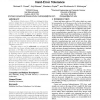Free Online Productivity Tools
i2Speak
i2Symbol
i2OCR
iTex2Img
iWeb2Print
iWeb2Shot
i2Type
iPdf2Split
iPdf2Merge
i2Bopomofo
i2Arabic
i2Style
i2Image
i2PDF
iLatex2Rtf
Sci2ools
ISCA
2009
IEEE
2009
IEEE
Architectural core salvaging in a multi-core processor for hard-error tolerance
The incidence of hard errors in CPUs is a challenge for future multicore designs due to increasing total core area. Even if the location and nature of hard errors are known a priori, either at manufacture-time or in the field, cores with such errors must be disabled in the absence of hard-error tolerance. While caches, with their regular and repetitive structures, are easily covered against hard errors by providing spare arrays or spare lines, structures within a core are neither as regular nor as repetitive. Previous work has proposed microarchitectural core salvaging to exploit structural redundancy within a core and maintain functionality in the presence of hard errors. Unfortunately microarchitectural salvaging introduces complexity and may provide only limited coverage of core area against hard errors due to a lack of natural redundancy in the core. This paper makes a case for architectural core salvaging. We observe that even if some individual cores cannot execute certain opera...
| Added | 24 May 2010 |
| Updated | 24 May 2010 |
| Type | Conference |
| Year | 2009 |
| Where | ISCA |
| Authors | Michael D. Powell, Arijit Biswas, Shantanu Gupta, Shubhendu S. Mukherjee |
Comments (0)

